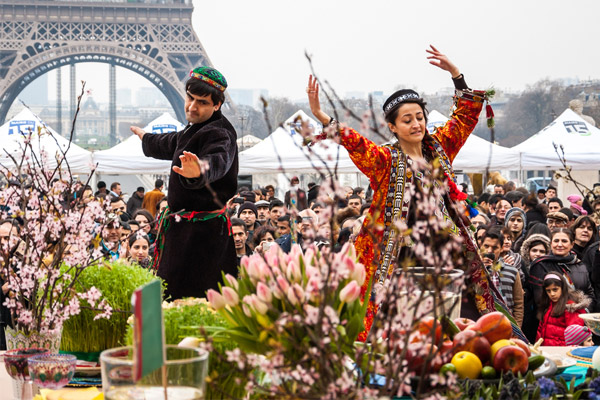
Baha’is Celebrate the New Year with Naw-Ruz
- By Alison Lesley --
- 23 Mar 2015 --

Dancers in traditional Persian costumes celebrate Nowruz (Iranian New Year) in Paris, France. Elena Dijour / Shutterstock.com
Baha’is celebrate the New Year on the vernal equinox with food and family on Naw-Ruz.
Naw-Ruz, also spelled Nowruz, is the Iranian and Bahá’í New Year celebrated on the day of the vernal equinox, which usually falls around 20th of March.
Celebrated as a holy day in the Baha’i Faith, along with other Iranians who commonly celebrate it as a secular holiday, it is one of the nine Bahá’í holy days on which work is suspended. Naw-Ruz marks the first month on the Iranian solar year. The day is the only holiday celebrated by more than one religious group in the country. Since ancient times, it has been tagged the great national holiday of Iran.
While not much is definitively known about how Naw-Ruz started, but, it most likely started as a fertility festival. Legend attributes the origin of the celebration to the antediluvian King Jamshid. Typical of other festivals celebrated at this time of year, Naw-Ruz is marked as a celebration of renewal and the coming spring.
Leading up to Naw-Ruz, celebrants observe a 19-day fast meant to focus believers on spiritual development, and some faithful believe that their actions on Naw-Ruz will affect the rest of the coming year. Naw-Ruz is typified with common forms of celebrations, but at its most basic, the holiday is seen as a period to tighten up ties with family, friends, and loved ones. Therefore cards are sent to associates, and friends and family sit around in groups to have communal meals.
After the break of the 19-day fast, celebrants assemble an age-long tradition called the haft-sin (or the “Seven S’s”). The dinner table is set up with seven traditional meals and items starting with the letter “S”. Some of these include sabza (wheat, barley or lentils that have been allowed to grow for several days in a dish), sepand (seeds of wild rue, generally burned as incense), sib (apples, symbolizing beauty and health), serka (vinegar, symbolizing age and patience), etc. The haft-sin is a deeply ingrained portion of Iranian Naw-Ruz celebrations, and the displays are a source of pride for families who often put considerable effort into their appearance so as to be pleasing to visitors.
The Baha’i have few rules dictating the celebration of Naw-Ruz. It is one of nine holidays on which work and school are to be suspended.
Resources


















